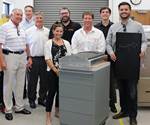3D Print the Tool to Cast the Mold to Make the Part
3D-printed molds to manufacture parts are familiar, but what if the mold itself was made with a 3D-printed tool? Catalysis Additive Tooling proves out this concept in a mold for a fiberglass part.
As its name implies, Catalysis Additive Tooling is no stranger to the design, manufacture and use of 3D-printed tooling. The Powell, Ohio, company leverages a network of partnerships to deliver end-use parts injection molded, vacuum formed or cast with 3D-printed tooling.
However, Catalysis is now experimenting with taking this concept a step farther—farther back in the supply chain, that is. In a recent case study the company 3D-printed tooling to make a mold that will ultimately produce a fiberglass composite part. The process worked like this:
- Catalysis had the cope and drag tooling 3D-printed from sand on an ExOne system at Humtown Products in less than 24 hours.
- Its sister foundry company cast aluminum into the sand tooling to make the two halves of the mold.
- The resulting two-part clamshell will be used to make a resin transfer molded (RTM) panel—a composite part that combines preform fiberglass reinforcement with resin injected into the mold.
In addition to the speed and cost savings possible in manufacturing tooling this way, the initial sand 3D-printed tool also enables the incorporation of unique design features. The aluminum mold in this case features fins on its back side to direct water flow and provide more surface area for uniform and controllable cooling; machining these fins into the mold would have been cost-prohibitive, but including this feature in the 3D-printed sand tooling was a simple process.
Darrell Stafford, Catalysis president and CEO, sees potential in this tooling strategy for manufacturing foam parts and other composites in addition to RTM parts.
"With constant pressure to reduce development time, the significant reduction in tool manufacturing time this method offers will dramatically support that initiative, and comes with a reduction in tooling costs as well,” Stafford says. "Couple time and cost savings with the virtually unlimited design freedom 3D printing allows, and new and innovative tooling concepts can be realized if put in the hands of ‘out of the box’ thinkers."
Related Content
-
Ice 3D Printing of Sacrificial Structures as Small as Blood Vessels
Using water for sacrificial tooling, Carnegie Mellon researchers have created a microscale method for 3D printing intricate structures small enough to create vasculature in artificial tissue. The biomedical research potentially has implications for other microscale and microfluidics applications.
-
3D Printing Supports Induction Coils — and Emergency Needs
As a participant in Michigan’s Project DIAMOnD initiative, Tucker Induction Systems received a 3D printer to use any way it saw fit, provided the capacity remains available in case of emergency. Use cases and lessons learned as part of this distributed manufacturing network.
-
Copper, New Metal Printing Processes, Upgrades Based on Software and More from Formnext 2023: AM Radio #46
Formnext 2023 showed that additive manufacturing may be maturing, but it is certainly not stagnant. In this episode, we dive into observations around technology enhancements, new processes and materials, robots, sustainability and more trends from the show.

.jpg;width=70;height=70;mode=crop)













